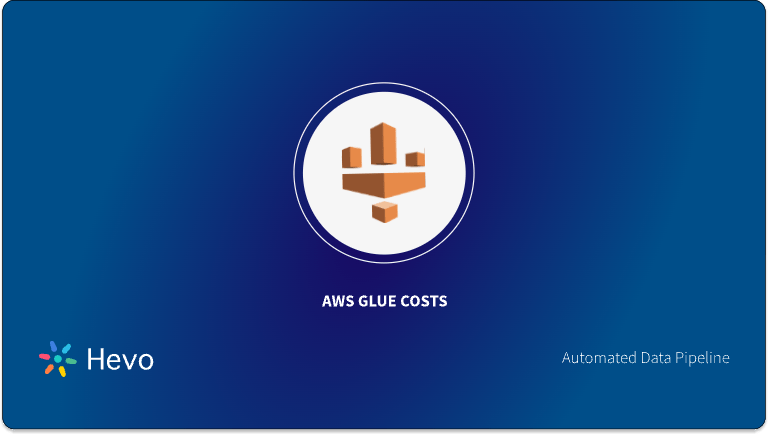 Key Takeaways
Key TakeawaysAWS Glue to Redshift data migration involves setting up proper IAM credentials and roles, then configuring Glue scripts to handle dynamic frames that transform and load data into Redshift tables.
Detailed breakdown of moving data from Glue to Redshift:
Step 1: Create Temporary Credentials and Roles using AWS Glue
Step 2: Specify the Role in the AWS Glue Script
Step 3: Handing Dynamic Frames in AWS Glue to Redshift Integration
Step 4: Supply the Key ID from AWS Key Management Service
Organizations are always looking for simple solutions to consolidate their business data from several sources into a centralized location to make strategic business decisions. This is due to the fact that using a Cloud-based solution allows organizations to ensure that their Data Warehouses scale up and down on demand and automatically suit all peak workload periods.
AWS Glue is a fully managed solution for deploying ETL (Extract, Transform, and Load) jobs. It lowers the cost, complexity, and time spent on building ETL jobs. It can be a good option for companies on a budget who require a tool that can handle a variety of ETL use cases. Amazon Redshift, on the other hand, is a Data Warehouse product that is part of the Amazon Web Services Cloud Computing platform. It allows you to store and analyze all of your data in order to gain deep business insights.
This article will guide you through the process of moving data from AWS Glue to Redshift. It will provide you with a brief overview of AWS Glue and Redshift. You will also explore the key features of these two technologies and the benefits of moving data from AWS Glue to Redshift in the further sections. Let’s get started.
Table of Contents
Prerequisites
Moving Data from AWS Glue to Redshift will be a lot easier if you’ve gone through the following prerequisites:
- An active AWS account.
- Working knowledge of Databases and Data Warehouses.
- Working knowledge of Scripting languages like Python.
Are you having trouble migrating your data into Redshift? With our no-code platform and competitive pricing, Hevo makes the process seamless and cost-effective.
- Easy Integration: Connect and migrate data into Redshift without any coding.
- Auto-Schema Mapping: Automatically map schemas to ensure smooth data transfer.
- In-Built Transformations: Transform your data on the fly with Hevo’s powerful transformation capabilities.
- 150+ Data Sources: Access data from over 150 sources, including 60+ free sources.
You can see it for yourselves by looking at our 2000+ happy customers, such as Meesho, Cure.Fit, and Pelago.
Get Started with Hevo for FreeWhat is AWS Glue?
Amazon’s AWS Glue is a fully managed solution for deploying ETL jobs. AWS Glue lowers the cost, complexity, and time spent on building ETL jobs. It can be a good option for companies on a budget who require a tool that can handle a variety of ETL use cases. It has 16 preload transformations that allow ETL processes to alter data and meet the target schema. Developers can change the Python code generated by Glue to accomplish more complex transformations, or they can use code written outside of Glue.
Key Features of AWS Glue
AWS Glue has gained wide popularity in the market. Some of the key features of AWS Glue include:
- You can connect to data sources with AWS Crawler, and it will automatically map the schema and save it in a table and catalog.
- AWS Glue automatically manages the compute statistics and develops plans, making queries more efficient and cost-effective.
- You can also deduplicate your data using AWS Glue. FindMatches is a feature in Glue that locates and deduplicates related data.
- Users such as Data Analysts and Data Scientists can use AWS Glue DataBrew to clean and normalize data without writing code using an interactive, point-and-click visual interface.
- Jobs in AWS Glue can be run on a schedule, on-demand, or in response to an event. To create complicated ETL pipelines, you can start many jobs simultaneously or specify dependencies between processes.
What is Amazon Redshift?

Amazon Redshift is a fully managed Cloud Data Warehouse service with petabyte-scale storage that is a major part of the AWS cloud platform. Amazon Redshift is a platform that lets you store and analyze all of your data to get meaningful business insights.
Key Features of Amazon Redshift
Amazon Redshift is one of the Cloud Data Warehouses that has gained significant popularity among customers. Some of the key features of Amazon Redshift include:
- Massively Parallel Processing (MPP): Massively Parallel Processing (MPP) is a distributed design paradigm in which multiple processors divide and conquer big data workloads. A huge processing work is split into smaller jobs and spread across a cluster of Compute Nodes. Instead of performing computations sequentially, these Nodes do in parallel.
- Fault Tolerance: For each Database or Data Warehouse user, data accessibility and reliability are critical. Amazon Redshift keeps a constant eye on its Clusters and Nodes. When a Node or Cluster fails, Amazon Redshift replicates all data to other nodes or clusters that are still operational.
- Columnar Design: Amazon Redshift has a Columnar Data Warehouse. As a result, firms can examine all of their data using their existing Business Intelligence tools in a straightforward and cost-effective manner.
- Redshift ML (Machine Learning): Redshift ML is a feature of Amazon Redshift that allows Data Analysts and Database engineers to quickly construct, train, and deploy Amazon SageMaker models using SQL.
- End-to-End Encryption: Amazon Redshift offers a variety of encryption methods that are both powerful and flexible. Users can choose the encryption standard that best meets their needs.
Steps to Move Data from AWS Glue to Redshift
Using the COPY command, here is a simple four-step procedure for creating AWS Glue Connect to Redshift connection. AWS Glue issues the COPY statements against Amazon Redshift to get optimum throughput while moving data from AWS Glue to Redshift. These commands require the Amazon Redshift cluster to use Amazon Simple Storage Service (Amazon S3) as a staging directory. Below are the steps you can follow to move data from AWS Glue to Redshift:
- Step 1: Create Temporary Credentials and Roles using AWS Glue
- Step 2: Specify the Role in the AWS Glue Script
- Step 3: Handing Dynamic Frames in AWS Glue to Redshift Integration
- Step 4: Supply the Key ID from AWS Key Management Service
Step 1: Create Temporary Credentials and Roles using AWS Glue
AWS Glue creates temporary credentials for you using the role you choose to run the job by default. These credentials expire after 1 hour for security reasons, which can cause longer, time-consuming jobs to fail.
You can solve this problem by associating one or more IAM (Identity and Access Management) roles with the Amazon Redshift cluster. The role can be used via the COPY command, and Amazon Redshift automatically refreshes the credentials as needed. Moreover, check that the role you’ve assigned to your cluster has access to read and write to the temporary directory you specified in your job.
Step 2: Specify the Role in the AWS Glue Script
After you’ve created a role for the cluster, you’ll need to specify it in the AWS Glue script’s ETL (Extract, Transform, and Load) statements. Your script’s syntax is determined by how it reads and writes your dynamic frame. You can provide a role if your script reads from an AWS Glue Data Catalog table. Below is the code to perform this:
glueContext.create_dynamic_frame.from_catalog(
database = "database-name",
table_name = "table-name",
redshift_tmp_dir = args["TempDir"],
additional_options = {"aws_iam_role": "arn:aws:iam::account-id:role/role-name"})Step 3: Handing Dynamic Frames in AWS Glue to Redshift Integration
If your script creates a dynamic frame and reads data from a Data Catalog, you can specify the role as follows:
glueContext.write_dynamic_frame.from_catalog(
database = "database-name",
table_name = "table-name",
redshift_tmp_dir = args["TempDir"],
additional_options = {"aws_iam_role": "arn:aws:iam::account-id:role/role-name"})In these examples, role name refers to the Amazon Redshift cluster role, while database-name and table-name relate to an Amazon Redshift table in your Data Catalog.
When you utilize a dynamic frame with a copy_from_options, you can also provide a role. The syntax is similar, but the connection options map has the additional parameter. Below is the code for the same:
my_conn_options = {
"url": "jdbc:redshift://host:port/redshift database name",
"dbtable": "redshift table name",
"user": "username",
"password": "password",
"redshiftTmpDir": args["TempDir"],
"aws_iam_role": "arn:aws:iam::account id:role/role name"
}
df = glueContext.create_dynamic_frame_from_options("redshift", my_conn_options)Step 4: Supply the Key ID from AWS Key Management Service
The data in the temporary folder used by AWS Glue in the AWS Glue to Redshift integration while reading data from the Amazon Redshift table is encrypted by default using SSE-S3. You must specify extraunloadoptions in additional options and supply the Key ID from AWS Key Management Service (AWS KMS) to encrypt your data using customer-controlled keys from AWS Key Management Service (AWS KMS), as illustrated in the following example:
datasource0 = glueContext.create_dynamic_frame.from_catalog(
database = "database-name",
table_name = "table-name",
redshift_tmp_dir = args["TempDir"],
additional_options = {"extraunloadoptions":"ENCRYPTED KMS_KEY_ID 'CMK key ID'"},
transformation_ctx = "datasource0"
) By performing the above operations, you can easily move data from AWS Glue to Redshift with ease.


Benefits of Moving Data from AWS Glue to Redshift
Moving data from AWS Glue to Redshift has numerous advantages. Some of the benefits of moving data from AWS Glue to Redshift include:
- Migrating data from AWS Glue to Redshift can reduce the Total Cost of Ownership (TCO) by more than 90% because of high query performance, IO throughput, and fewer operational challenges.
- Migrating Data from AWS Glue to Redshift allows you to handle loads of varying complexity as elastic resizing in Amazon Redshift allows for speedy scaling of computing and storage, and the concurrency scaling capability can efficiently accommodate unpredictable analytical demand.
- Auto Vacuum, Auto Data Distribution, Dynamic WLM, Federated access, and AQUA are some of the new features that Redshift has introduced to help businesses overcome the difficulties that other Data Warehouses confront. Moreover, moving data from AWS Glue to Redshift will provide you with automated maintenance.
Hevo helps you simplify Redshift ETL where you can move data from 150+ different sources (including 60+ free sources).
Conclusion
Overall, migrating data from AWS Glue to Redshift is an excellent way to analyze the data and make use of other features provided by Redshift. This article gave you a brief introduction to AWS Glue and Redshift, as well as their key features. You also got to know about the benefits of migrating data from AWS Glue to Redshift. However, loading data from any source to Redshift manually is a tough nut to crack. You will have to write a complex custom script from scratch and invest a lot of time and resources. Furthermore, such a method will require high maintenance and regular debugging.
Hevo Data provides an Automated No-code Data Pipeline that empowers you to overcome the above-mentioned limitations. You can leverage Hevo to seamlessly transfer data from various sources to Redshift in real-time without writing a single line of code. Hevo’s Data Pipeline enriches your data and manages the transfer process in a fully automated and secure manner. Hevo caters to 150+ data sources (including 40+ free sources) and can directly transfer data to Data Warehouses, Business Intelligence Tools, or any other destination of your choice, hassle-free. Sign up for a 14-day free trial to make your life easier and data migration hassle-free.
Share your experience of moving data from AWS Glue Redshift in the comments section below!
FAQ on AWS Glue to Redshift
Does AWS Glue support Redshift?
Yes, AWS Glue supports Amazon Redshift. You can use AWS Glue to extract, transform, and load (ETL) data into Redshift, as well as to read data from Redshift for further processing or analysis.
What is AWS Glue compatible with?
AWS Glue is compatible with various AWS data stores, including Amazon S3, Amazon RDS, Amazon Redshift, and DynamoDB. It also supports connections to external databases like MySQL, PostgreSQL, and Oracle, as well as JDBC-compliant databases.
Can AWS Glue connect to REST API?
AWS Glue does not natively connect to REST APIs. However, you can use AWS Glue with custom connectors or use AWS Lambda in conjunction with AWS Glue to interact with REST APIs and process the data as part of your ETL workflow.










